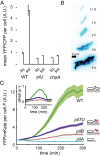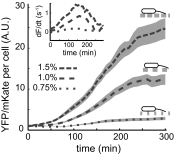Type IV pili mechanochemically regulate virulence factors in Pseudomonas aeruginosa
- PMID: 26041805
- PMCID: PMC4475988
- DOI: 10.1073/pnas.1502025112
Type IV pili mechanochemically regulate virulence factors in Pseudomonas aeruginosa
Abstract
Bacteria have evolved a wide range of sensing systems to appropriately respond to environmental signals. Here we demonstrate that the opportunistic pathogen Pseudomonas aeruginosa detects contact with surfaces on short timescales using the mechanical activity of its type IV pili, a major surface adhesin. This signal transduction mechanism requires attachment of type IV pili to a solid surface, followed by pilus retraction and signal transduction through the Chp chemosensory system, a chemotaxis-like sensory system that regulates cAMP production and transcription of hundreds of genes, including key virulence factors. Like other chemotaxis pathways, pili-mediated surface sensing results in a transient response amplified by a positive feedback that increases type IV pili activity, thereby promoting long-term surface attachment that can stimulate additional virulence and biofilm-inducing pathways. The methyl-accepting chemotaxis protein-like chemosensor PilJ directly interacts with the major pilin subunit PilA. Our results thus support a mechanochemical model where a chemosensory system measures the mechanically induced conformational changes in stretched type IV pili. These findings demonstrate that P. aeruginosa not only uses type IV pili for surface-specific twitching motility, but also as a sensor regulating surface-induced gene expression and pathogenicity.
Keywords: mechanotransduction; surface sensing; type IV pili; virulence.
Conflict of interest statement
The authors declare no conflict of interest.
Figures




References
-
- Galán JE, Collmer A. Type III secretion machines: Bacterial devices for protein delivery into host cells. Science. 1999;284(5418):1322–1328. - PubMed
-
- Cornelis GR. The type III secretion injectisome. Nat Rev Microbiol. 2006;4(11):811–825. - PubMed
-
- Yahr TL, Wolfgang MC. Transcriptional regulation of the Pseudomonas aeruginosa type III secretion system. Mol Microbiol. 2006;62(3):631–640. - PubMed
Publication types
MeSH terms
Substances
Grants and funding
LinkOut - more resources
Full Text Sources
Other Literature Sources

